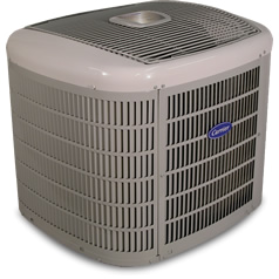Glossary
Air Conditioning and Heating Terms
S
Seasonal Energy Efficiency Ratio (SEER)
A measure of seasonal or annual efficiency of a central air conditioner or air conditioning heat pump. It takes into account the variations in temperature that can occur within a season and is the average number of Btu of cooling delivered for every watt-hour of electricity used by the heat pump over a cooling season.
Setback Thermostat
A thermostat that can be set to automatically lower temperatures in an unoccupied house and raise them again before the occupant returns.
Soffit
A panel which covers the underside of an roof overhang, cantilever, or mansard.
Space Heater
A movable or fixed heater used to heat individual rooms.
Specific Humidity
The weight of water vapor, per unit weight of dry air.
Split System Air Conditioner
HVAC term for an air conditioning system that comes in two to five pieces: one piece contains the compressor, condenser, and a fan; the others have an evaporator and a fan. The condenser, installed outside the house, connects to several evaporators, one in each room to be cooled, mounted inside the house. Each evaporator is individually controlled, allowing different rooms or zones to be cooled to varying degrees.
Stack
A smokestack or flue for exhausting the products of combustion from a combustion appliance.
Stack (Heat) Loss
Sensible and latent heat contained in combustion gases and vapor emitted to the atmosphere.
Stack Effect
The overall upward movement of air inside a building that results from heated air rising and escaping through openings in the building super structure, thus causing an indoor pressure level lower than that in the soil gas beneath or surrounding the building foundation.
Stand-by Heat Losses
A term used to describe heat energy lost from a water heater tank.
Static Pressure
Condition that exists when an equal amount of air is supplied to and exhausted from a space. At static pressure, equilibrium has been reached.
Steam
Water in vapor form; used as the working fluid in steam turbines and heating systems.
Steam Boiler
A type of furnace in which fuel is burned and the heat is used to produce steam.
Storage Water Heater
A water heater that releases hot water from the top of the tank when a hot water tap is opened. To replace that hot water, cold water enters the bottom of the tank to ensure a full tank.
Supply Duct
HVAC term for the duct(s) of a forced air heating/cooling system through which heated or cooled air is supplied to rooms by the action of the fan of the central heating or cooling unit.
Condensing Unit
The device in an air conditioner or heat pump in which the refrigerant condenses from a gas to a liquid when it is depressurized or cooled.

Condenser Coil
The device in an air conditioner or heat pump through which the refrigerant is circulated and releases heat to the surroundings when a fan blows outside air over the coils. This will return the hot vapor that entered the coil into a hot liquid upon exiting the coil.
Condensing Unit
The component of a central air conditioner that is designed to remove heat absorbed by the refrigerant and transfer it outside the conditioned space.
Conditioned Air
Air that has been heated, cooled, humidified, or dehumidified to maintain an interior space within the “comfort zone.” (Sometimes referred to as “tempered” air.)
Conditioned Space
The interior space of a building that is heated or cooled.
Constant Air Volume Systems
Air handling system that provides a constant air flow while varying the temperature to meet heating and cooling needs.
Cooling Capacity
The quantity of heat that a cooling appliance is capable of removing from a room in one hour.
Cooling Degree Day
A value used to estimate interior air cooling requirements (load) calculated as the number of degrees per day (over a specified period) that the daily average temperature is above 65 degrees Fahrenheit (or some other, specified base temperature). The daily average temperature is the mean of the maximum and minimum temperatures recorded for a specific location for a 24 hour period.
